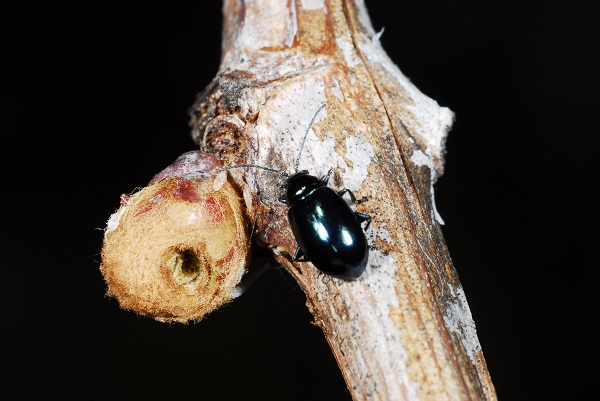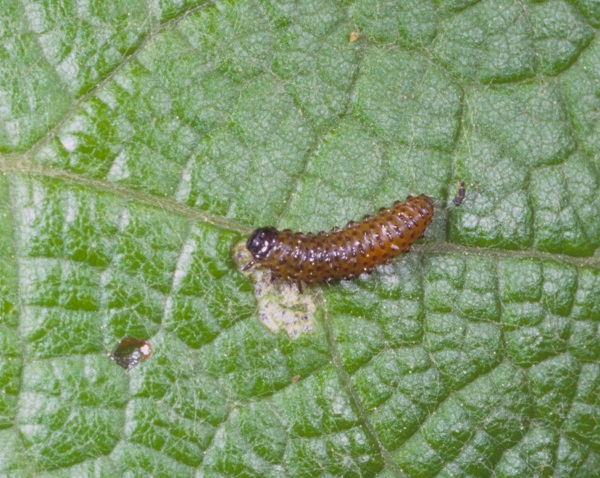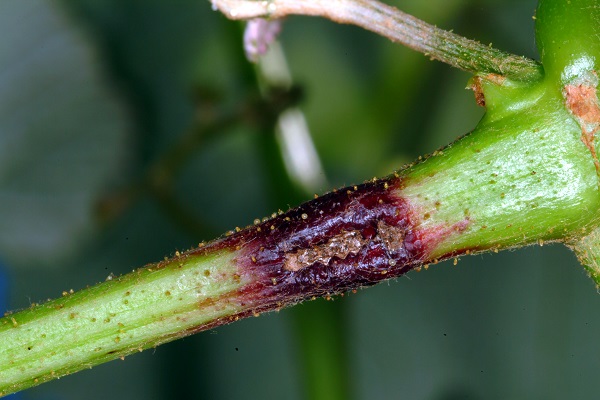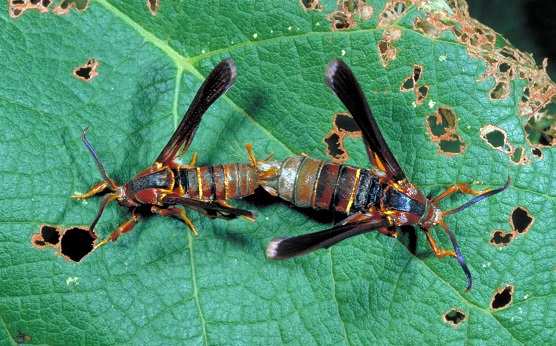Grape Insects
ENTFACT-208: Grape Insects | Download PDF
by Ric Bessin, Extension Specialist
University of Kentucky College of Agriculture
Grape Berry Moth
The grape berry moth is a key pest of grapes that is distributed in the United States east of the Rocky Mountains, and in eastern Canada. The larvae of this insect can cause serious damage to commercial vineyards by feeding on the blossoms and berries. Infested berries may appear shriveled with fine webbing. Damage by grape berry moth may increase mold, rots and numbers of fruit flies. While grape berry moth larvae may only damage a few berries in a cluster, it is impractical for growers to remove damaged berries and webbing from clusters. Hosts include wild and cultivated grapes.

Figure 1. Grape berry moth larva.
The adult moth is small, active, and about 1/4 inch long. When it is at rest with its wings folded, there is a brown band across the middle of the insect, the hind portion is gray-blue with brown markings, while the front portion is gray-blue without markings. The full-grown larva is 2/5 inch long, pale olive-green, and can have a purplish tinge from the food it has eaten. The pupa is about 1/5 inch long, greenish-brown to dark brown and found under a flap cut in the leaf surface.
The grape berry moth overwinters as a pupa in leaf litter under vines. Adults begin to emerge in late May and lay eggs of the first generation singly on fruit stems just before blossom time. Eggs hatch in about 5 days. Under a flimsy web, the larvae feed for about 21 days on the blossoms and young fruit. In mid to late July, larvae move to leaves where they make a semi-circular slit, fold the flap over themselves and pupate. Adult moths emerge from the pupae in 10 to 15 days. Moths begin laying eggs for the next generation after 4 to 5 days. There may be 2 or 3 generations per year. Larvae of the second and third generations enter berries and feed within, passing from one berry to another under protection of webbing. Some of the cocoons of the second or third generations fall to the ground where they overwinter.
Webbing over blossoms and berries, and leaf flap cocoons are indicative of grape berry moth. In winter, the cocoons may be found in leaf litter under the vines. Clean up or bury leaf litter under vines in winter to eliminate over wintering pupae. Although larvae first appear when the grapes are in bloom, insecticides should not be applied until the berries are the size of small peas so as not to destroy beneficial pollinators. Insecticidal control of second generation is more difficult due to an extended flight period of moths as well as the difficulty of getting adequate spray coverage inside the cluster as berry size increases.
Pheromone traps are available to monitor for adult moth activity and enhance timing of insecticides for grape berry moth control. Recent studies in some states have shown mating disruption with synthetic pheromones to be an effective alternative in situations where there is no immigration of moths from outside sources. Mating disruption relies on releasing enough of the pheromone in the vineyard so that males cannot find female moths. Pheromone is imbedded in 8-inch plastic twist-ties using 400 twist ties per acre. Commercial systems available for mating disruption for this insect are recommended for vineyards at least 5 acres in size.

Figure 2. Grape phylloxera galls.
Grape Phylloxera
Grape phylloxera is native to eastern United States, but has been distributed to other grape regions of the U.S. and is also established in Europe where it is of great economic importance. The leaf galls caused by grape phylloxera are unsightly and do little damage, however, infestation of the roots can be difficult to control and can lead to decline of vines. Severe infestations can cause defoliation and reduce shoot growth. Hosts include cultivated and wild grapes.
The wingless forms of the insect are very small, yellow-brown, oval or pear-shaped, and aphid-like. The winged forms, which are less apt to be seen, are also aphid-like, except that wings are held flat over the back. Neither winged nor wingless forms have cornicles, tail pipe-like structures on the top of the abdomen, as aphids do.
The presence of grape phylloxera is best recognized by characteristic galls it produces on the leaves or roots. Leaf galls are wart-like, about 1/4 inch in diameter, and are familiar to anyone growing grapes. Root galls are knot-like swellings on the rootlets, and may lead to decay of infested parts.
Root galls cause stunting and/or death of European varieties of grape vines. American varieties of grapes, or European grapes on American root stock are tolerant to the root gall form of the insect. Some varieties are resistant are to root galls, leaf galls or both.
The life cycle of grape phylloxera is complex due to the fact that generations with different life cycles may develop at the same time, at least in the eastern US. In spring, a female hatches from a fertilized egg that had been laid on the wood of a grape vine. She migrates to a leaf where she produces a gall and grows to maturity in about 15 days. She fills the gall with eggs and dies soon afterward. Nymphs that hatch from these eggs escape from the gall, and wander to new leaves where they in turn produce galls and eggs. There maybe 6 or 7 generations of this form during the summer. In the fall, nymphs migrate to the roots where they hibernate through the winter. The following spring they become active again and produce the root galls on susceptible varieties of grapes. These wingless females may cycle indefinitely on the roots year after year. In late summer and fall, in the eastern U.S., some of the root inhabiting phylloxera lay eggs that develop into winged females. These females migrate from the roots to the stems where they lay eggs of two sizes, the smaller ones developing into males and the larger ones into females. Mating occurs and the female then lays a single fertilized egg that over winters on the grape stem. It is this egg that gives rise to leaf inhabiting generations. Phylloxera cycle continuously as root inhabitants. Although they can cycle continuously on the roots without leaf forms occurring, leaf-inhabiting forms do not occur without the root form also occurring.
European varieties of grapes should be grafted onto American grape rootstocks. Foliar sprays to control phylloxera during their wandering stage do not accomplish any useful purpose.
Grape Rootworm
Grape rootworm is distributed from the Mississippi River eastward. Larvae devour small roots and pit the surface of larger roots, causing an unthrifty condition of the plant, and reduction in yield. Vines may be killed in 3 or more years when damage is severe. Adults make chain-like feeding marks on leaves and may also feed on the surface of green grape berries. Hosts include wild and cultivated grapes.
The adult beetle is elongate oval, sub-cylindrical, dark reddish brown, clothed with short pubescence and is about 1/4 to 1/3 inch long. The larva is white, hairy, curved, with a brown head.
Grubs in various stages of development pass the winter in soil at a depth of a few inches to 2 or more feet. In the spring, they migrate to within 1 or 2 inches of the soil surface, where they root feed for a while before forming a small earthen cell to pupate in late May and June. Adults emerge over a period of 4 to 6 weeks, beginning about 2 weeks after grapes bloom, and feed on leaf upper surfaces in a characteristic manner. Soon after feeding begins, females lay eggs in masses of 20 to 30 on canes, usually under loose bark. Eggs hatch in 1 to 2 weeks, larvae drop to the ground, and enter the soil where they feed until the approach of cold weather. There is one generation per year.
Chain-like leaf feeding damage by the adults is diagnostic and can alert growers to adult activity. Foliar sprays when adults are active can provide effective control.

Figure 3. Grape flea beetle and damage to grape bud.
Grape Flea Beetle
Grape flea beetle is found in the eastern two-thirds of the United states. Adults eat buds and unfolding leaves, causing leaves to be ragged and tattered. Larvae feed on flower clusters and skeletonize leaves in a manner similar to adult rootworm feeding. Hosts include grape, plum, apple, quince, beech, elm & Virginia creeper.
Adults are dark metallic greenish-blue, jumping beetles about 1/5 inch long; larvae are brownish and marked with black spots; eggs are pale yellow, and fairly conspicuous on upper leaf surface or under loose cane bark.

Figure 4. Grape flea beetle larva.
Adults overwinter in protected areas around vineyards, and start feeding on interior of primary buds and opening grape leaves in early spring. Damaged buds will not develop into primary canes which can reduce yields. Once the buds are 1/2 inch long, only slight injury is caused. The females lay eggs under loose cane bark on vines, or occasionally on leaf upper surfaces, or on buds. The light yellow fairly conspicuous eggs hatch in a few days. The larvae feed on leaves for 3 to 4 weeks, then drop to the ground where they pupate in the soil, and emerge as adults in 1 to 2 weeks later. New adults feed for the remainder of the summer and go into hibernation in fall. There is only 1 generation per year.
Damage is often restricted to vineyard borders, particularly near wooded areas. Scheduled sprays for grape berry moth and leafhoppers provide effective control. Where flea beetles have been a problem, a spray timed at bud swell can provide control.
Grape Cane Girdler
Grape cane girdler is common in central and eastern United States. Adults girdle canes with a row of punctures, that causes canes to break off at the girdled areas. It is only a minor pest on grape, preferring Virginia creeper. Hosts include grape and Virginia creeper.

Figure 5. Grape cane girdler and damage.
The adult is a black snout beetle about 1/8 inch long. The grub is slightly larger when full grown, and is white with a brown head and legless. It is very similar in appearance to the closely related grape cane gall maker.
Eggs are laid in late spring in a series of holes encircling the cane made by the female using its mouthparts. After eggs are laid, the female continues to make another series of punctures a few inches below the first girdle until the cane is encircled, but eggs are placed only in the holes of the first girdle. A similar girdle is made at a point higher on the cane, causing the end to break. Grubs feed in the cane pith between the girdles. After larval development is completed, pupation occurs. Adults appear in late summer, go into hibernation, and reappear in late spring.
Girdles are usually beyond the fruit clusters and do not cause significant yield loss. Look for broken off, pencil-sized canes with a grub in the pith of each broken off section, or wilted canes with a series of punctures. Pruning canes a few inches below the lower girdled area is usually sufficient control for this pest. Pruning should be done before adult emergence in late July or August.
Grape Cane Gallmaker
Grape cane gallmaker is a common pest of grapes in Kentucky. This insect produces noticeable red galls on new shoot growth just above nodes. While these are commonly found in vineyards, the majority of the galls are beyond the fruit clusters and usually cause no serious yield loss. Canes with galls are capable of producing a crop the following year.

Figure 6. Grape cane gallmaker damage.
The adult is a dark brown snout beetle about 1/8 inch long and is very similar in appearance to the grape cane girdler. The grub is slightly larger when full grown, and is white with a brown head and legless.
In May and June, the female lays an egg in one of a series of holes she chews along the cane just above a node when canes are 10 to 20 inches long. The larva feeds inside the cane which has developed a reddish swelling 3/4 to 1 inch long. The larva becomes fully developed in late July and pupates within the gall. Adult beetles emerge during August and remain in or near the vineyard area, overwintering in trashy borders.
Galls are usually found along vineyard borders near wooded trashy areas or at the ends of rows. If galls will be removed by pruning, it should be done by mid-July before emerging adults exit galls.
Grape Root Borer
Grape root borer is potentially the most destructive insect attacking grapes in Kentucky. Larvae of this insect tunnel into the larger roots and crown of vines below the soil surface. Borer damage results in reduced vine growth, smaller leaves, reduced berry size, and fewer bunches of grapes. Because damage is restricted to below ground, problems often go unnoticed until vine decline is observed. Damage caused by larval feeding can range from just a few feeding sites to complete root system destruction.

Figure 7. Mating pair of grape root borer moths.
Adults are brown moths with thin yellow bands on the abdomen and resemble some paper wasps. The front wings are brown while hindwings are clear. Male moths fly about in a manner similar to wasps. Larvae are cylindrical, cream-colored, with three pairs of true legs near the head and five pairs of fleshy abdominal prolegs each bearing two bands of tiny hooks. The larvae are 1-1/2 inch long when mature and have a retractable brown head.
Adults emerge from the soil in mid summer. Eggs are laid on the soil surface, grape leaves, and weeds with eight days of adult emergence. Females lay an average of 350 eggs. Eggs hatch in about two weeks and larvae immediately tunnel into the soil in search of grape roots. About 95% of the larvae die before reaching roots, but less than 1% die after finding grape roots. Larvae will feed on the roots for 2 years. During the summer of the second year, larvae will pupate near the soil surface.
Injury by root borers is often most severe in low, poorly drained areas of the vineyard. In mid-summer, growers should examine around the bases of vines out to a distance of 18 inches for empty pupal skins of grape root borer. If pupal skins are found beneath 5% of the vines then an insecticide application is recommended next year underneath vines. It is best to apply the insecticide just as the adults are beginning to emerge, but the preharvest interval may make it necessary to spray after harvest. The insecticide should be applied as a course spray to a 15 square foot area surrounding the vine. Treat with an insecticide only if necessary. If grape root borer is not a problem, there is no reason to risk destroying the natural control processes and increasing production costs.
Redbanded Leafroller
Redbanded leafroller is an occasional pest of clusters and fruits, and its symptoms are very similar to grape berry moth. Larvae of this insect will feed on both foliage and clusters. Unlike grape berry moth larvae, redbanded leafroller larvae do not crawl into the berry but remain concealed in webbing on the cluster stem and feed on the stem as well as berries. While redbanded leafrollers are numerous in Kentucky, they are only an occasional pest of grapes.
The adult redbanded leafroller is a 1/2 inch long reddish-brown moth with small areas of silver, gold and orange. The moth is recognized by the red band extending across the front wings when at rest. The larva is a small, yellowish-green, unmarked caterpillar. The head capsule is the same color as the rest of the body.
The redbanded leafroller overwinters as pupae in leaf litter on the soil surface. Adults emerge in April and begin laying clusters of eggs on canes. Larvae of this early generation feed on unfolding leaves and are not usually of major concern. Larvae of the second and third generations feed during the summer and are of economic importance due to berry feeding. Second and third generations are larger than the first, and egg laying occurs over an extended period of time.
Growers can control for redbanded leafrollers at petal fall or when presence of the pest is detected. Pheromone traps are available to monitor for redbanded leafroller. Trap catches are an indication of moth activity and can be used to more accurately time insecticide applications.
General Management Guidelines
There are a number of cultural control practices that grape growers need to use to reduce problems caused by insect pests. These cultural practices include:
- Burying or removing leaves under the vines during the winter.
- Summer pruning vines to remove grape cane gallmaker and grape cane girdler before adult emergence.
- Use American rootstocks resistant to grape phylloxera.
- Maintain good weed control during the season, and eliminate weedy or trashy harborages around the vineyard that serve as overwintering sites for pests.
Use systematic scouting of vineyards to monitor for grape insects on a regular basis. Particular attention should be made to the ends of rows and rows bordering wooded areas. It is on these vines that insect problems may develop initially and with the greatest severity. During mid-summer, growers should examine around the bases of vines for evidence of grape root borer emergence. Growers should record and maintain notes of each visit to the vineyard. See ID-93, Kentucky Commercial Small Fruit & Grape Spray Guide, for a listing of the recommended insecticide sprays.
Revised: 11/19
CAUTION! Pesticide recommendations in this publication are registered for use in Kentucky, USA ONLY! The use of some products may not be legal in your state or country. Please check with your local county agent or regulatory official before using any pesticide mentioned in this publication.
Of course, ALWAYS READ AND FOLLOW LABEL DIRECTIONS FOR SAFE USE OF ANY PESTICIDE!
Photos courtesy Ric Bessin, University of Kentucky Entomology
